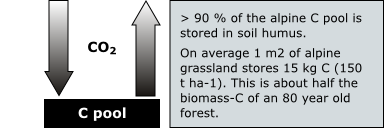The carbon balance of alpine ecosystems
The carbon balance of an ecosystem is the difference between the long term uptake and loss of carbon over a larger area.

Since an increasingly larger fraction of the alpine landscape is barren as one moves from the treeline to the highest peaks, the average C storage per unit of land area is commonly much smaller, about 5-10 kg m-2 in the Swiss Alps between 2000 and 2600 m altitude, as compared to below alpine elevations (Fig. 2).
In late successional ecosystems the carbon balance is commonly close to zero, which means that the C-pool is constant. This has been confirmed for alpine grass heaths and alpine dwarf shrub heaths in the Alps. There are two major ways through which the C-balance can be positive or negative. C-accretion can happen during colonisation of raw substrates (e.g. after the retreat of a glacier) and a loss of carbon can result from soil disturbance (e.g. overgrazing, erosion, trampling, building of ski slopes etc.).

